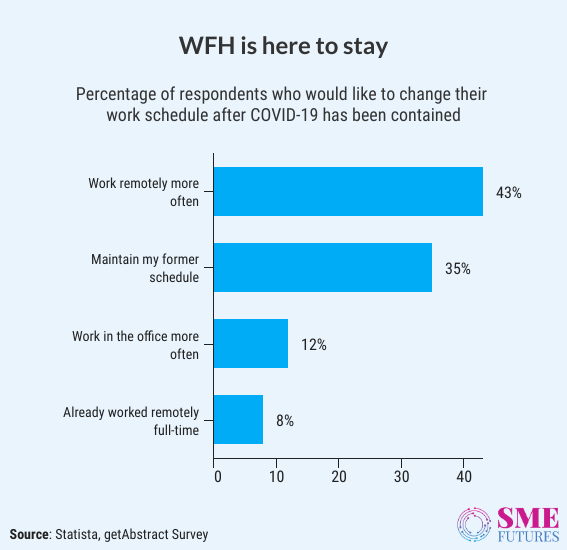The culture of work from home was earlier confined to IT oriented businesses or publishing conglomerates till coronavirus hit the world. In past two to three months, workplaces experienced a paradigm shift as work from home (WFH) became a necessity for organisations to ensure safety of both employees and management.
Certainly, times have changed as glass ceilings of workplaces have shattered. Earlier, management of any company considered work from home a privilege for few employees, but it has now become a new normal for everyone in any firm. Many organisations are therefore looking at the possibility of moving everything online and accomplishing everything through digital workspaces.
Tata Consultancy Services is planning to asked 75 per cent of its 4.48 lakh employees (3.5 lakh in India) to work from home till 2025. Currently, 20 per cent of its workforce is working remotely. This clearly indicates that though remote working was always there, COVID-19 pandemic has just pressed the fast-forward button.
Past, Present and Future of Remote Working
According to books, it was Jack Nilles who first proposed the idea of bringing work closer to employees. In his book ‘The Telecommunications-Transportation Tradeoff’ published in 1976, he proposed the idea of telecommuting as computers can’t be installed everywhere.
An Insurance company in Los Angeles tested this theory on its employees and experienced an increased productivity with extremely less facilities cost. Since then, the idea of flexible working has evolved with reduced infrastructural requirements and revolution in technology.
In the early 1990’s, a French economist Jacques Attali predicted that the future will be dependent on remote working. His ideology stated that people with free lifestyle prefer to travel for work anywhere. For instance, Kolkata was a preferred choice for industrialists in pre-independent era. But, in today’s world jobs are generated in cities where maximum skilled workers reside.
Moreover, tech-savvy workforce is embracing the idea of remote working overwhelmingly. They opt for it due to comfort of working from home and convenience in choosing time to work.

Increasing Feasibility of Remote Working
Coping ahead with the new normal, people are now trying to find innovative ways to increase efficiency in their work. Unlike before, each sector is embracing well with the change. Human resource experts are of opinion that the trend is not going anywhere in coming years.
Commenting on the new paradigm of working, Rajaram Agrawal, MD at TalentAhead India tells that India will be adopting remote working for a longer period as it has emerged as a popular business model.
He says, “COVID-19 crisis has virtually forced organisations to adopt remote-working during the various stages of lockdown. Coupled with the power of enabling technologies, remote working is proving to be a boon for both employers and employees. Hence, we see remote working as a business model and not a mere HR practice.”
The trend is destined to attain pace even after post-COVID times. A survey by TimesJobs also foresees the similar trend in future. Also, ‘The Big HR survey’ states that 63 per cent (6 out of 10) Indian HR managers are of opinion that their firms are likely to continue virtually even after everything normalizes.
In addition to this, 27 per cent of the surveyed companies have created virtual offices for seamless work communication and employee engagement. The HR managers of these companies also accept investing in the collaborative tools for seamless work performance. Sanjay Goyal, Business Head at TimesJobs and TechGig adjudges virtual or remote work culture as a big disruption for India Inc as Indian workplaces were never virtual work friendly.
He suggests, “TimesJobs has been saying that virtual working will be the next big thing at workplaces. The COVID-19 lockdown that led to mass digital adoption has just proved our point. I won’t be surprised if more offices will now consider moving some roles to remote working permanently.”
Considering the current scenario of workplaces, IndiaFiling’s COO and HR Head, Reeni Lionel also believes that remote working culture is only going to rise. She adds, “Large conglomerates like Tata and Infosys are already planning to make 75 per cent of their workforce working from home.”
She further says, “In my opinion, it is a win-win situation according to organisation’s perspective as they get to save costs such as on premises rent, electricity etc. Secondly, we are also noticing surge in productivity. So, yes I do believe that most people who have opportunity to WFH will continue to do so at least for the next one year.”
Similarly, Indian organisations which have embraced the new normal of work culture enthusiastically, know well that remote work is the future for them. Prashanth GJ, CEO at TechnoBind, a tech solution provider says, “The workplace has changed unknowingly not only for now but for future as well.”
Talking about his firm Prashanth says that they have realized that working remotely is a viable option for now and has no significant effect on the efficacy of work delivery. He confesses, “In fact, this can be more productive with less travel time of employees, decreased stress related to being stuck in traffic, and ability to work from comfort of home.”
According to industry experts, this will also push organisations to fully commit to exponential solutions such as cloud-based flexibility soon. This will include a hybrid multi-cloud design and a service strategy for leveraging partners to supplement provision which will ensure robust remote working environments.
Flexibility of Working Hours Preferable for Everyone
Philip, a guitarist on a social site presents his opinion on this trend, “I find work from home very productive. There are no interruptions and you can focus on tasks based on your priority.” Similarly, Harish who is a photographer by profession tells that working remotely for him means flexible expectations for completion of work.
Remote work is not new for these gig workers. With benefits such as working in your sweatpants or pyjamas from any location, flexible schedule, and increased time with family and friends, work from home is always a preferred choice for individuals in creative pursuits.
Discussing with SMEFutures Neeraj Agarwal, Founder of The Learning Solution, an HR consulting firm based in Mumbai talks about advantages and disadvantages of remote working. According to him, workplaces have totally transformed because of ease of working from comfort of home. Numerous firms are experiencing spike in productivity due to this.
He observes that workplaces have changed from normal office premises to home offices where employees get to spend more time with family along with no stress of routine commuting. He further adds, “Think of the challenge if your office is in South Bombay and you live in North Bombay, it will be a war for you in any normal day. Hence, work from home is a blessing in disguise as it saves both time and money.”

The Other Side of Coin
Every policy has advantages and disadvantages. Hence, remote work can also be challenging. Agarwal says, “It can be distracting if you lack proper corner for work corner at your home. Also, you don’t get to meet your colleagues in person. Sometimes, you need to connect with your peers and superiors but here you are in confined space surrounded by digital solutions and technology.”
The TimeJobs survey shows that 74 per cent of HR managers are receiving queries related to job security and salary payments and 13 per cent said they are receiving queries on workplace policies. According to Neeraj Agarwal, employees are also concerned about their efforts not being appreciated enough.
There is another aspect of work from home scenario. Sectors such as education, IT/ITES, BPOs, consultancies etc can manage working from home but everyone cannot. Employees of sectors such as service industry, Construction, hospitality, and tourism can only do best while they are on field. Such organisations therefore have seen some tough times lately.
For instance, it was challenging to work for home for employees being in the sales and service business such as for Big Boy Toyz that deals with pre-owned automobiles. As a result, business was shut during the initial days of the lockdown.
Jatin Ahuja, the founder and CEO says, “We have a strong workforce of 150 members in our team. Hence, we firmly believe that we can sail through the situation together.” Explaining the current opportunities in the market, Ahuja confesses, “It is necessary to grab the sales share at this point. Almost 75 per cent strength is back and we are working to accomplish our goals.”
Along with this, continuity of this trend also likely to depend upon the nature of the sector and kind of industries people are working in. Commenting on this Khaja Najumudeen, Chief Manager-HR at Navin’s, Chennai based real estate firm says, “Observing the current scenario, it is quite possible now that firms are going to go ahead with remote work policy for a considerable time now.”
He adds further, “But, 100 per cent WFH is not possible in sectors such as real estate and construction. Initially everything was shut but now construction projects have resumed under strict supervision. Construction operations are likely to be fully functional in six months or nearly a year.” He also tells that organisations cannot compel people to reach to their workplaces.
Permanent Workforce Versus Gig Economy
The COVID-19 health crisis has shut many businesses and numerous people have lost their jobs. According to an estimate by Global Consultants, India is set to lose around 130 million jobs due to current economic crisis. This includes 40 per cent employees from blue collar jobs.
Interestingly, a report by Indeed India depicts that people are looking for more work from home opportunities. The report states that job searches for remote work surged by over 377 per cent during February to May during the lockdown. Similarly, job postings for work from home opportunities and remote work have also seen an increase of 168 per cent.
Managing Director, Indeed India, Sashi Kumar reclaims, “COVID-19 has forced many of us to change the way we work, powering a huge shift towards remote working which is expected to continue. It is here that industries need to think collaboratively to develop future proof workforce strategies and support at-risk workers in re-skilling and up-skilling.”
In some of its previous studies, the firm found that 83 per cent of job seekers consider remote work policy an important factor when searching for a job. In addition to this, 53 per cent of employees would consider taking a pay cut in order to have access to remote working options. Also, about 83 per cent of employers concur that offering flexibility in working can help boost productivity.
Adding to this, TalentAhead’s Agrawal says that people are becoming fond of the idea of flexible work alternatives. “I foresee that a large untapped work-force will be eager to join the bandwagon of new flexible working option. Many female employees find it difficult to manage family responsibilities along with conventional office jobs due to extended working hours including the travel time.”
According to him, gig economy is expected to grow exponentially as numerous millennials and young workers are keen to adopt this model. As a result, companies are expected to increase productivity or output linked salary and reduce fixed compensation to maintain the cost of gross-salary-cost same for a given job.
Therefore, gig economy is on its way to become a crucial part of business strategies even if permanent workforce has its own place. According to ASSOCHAM, the size of the gig economy is projected to grow at a CAGR of 17 per cent and is likely to hit a gross volume of $455 billion by 2023.
However, HR experts do feel organizations’ reliance on gig workers is a short-term resolve. Talking on the subject Lionel of IndiaFilings opines, “Definitely there are some sectors that are going to get benefit from employing more contractual workers rather than permanent workforce. But I feel loyalty will always be missing with gig workers. Hence, it can be just a temporary trend to cut costs.”
On the other hand, Najumudeen believes that permanent workforce is not going to extinct. However, their existence depends upon the recovery of the sectors. He proclaims, “If badly afflicted sectors do not revive soon, it can adversely affect permanent workforce. But seeing the economic scenario, I feel that sectors have already gained snail-paced recoveries. Thus, there will be a mix up of contractual workers and permanent employees.”
Flexible Work Responsibilities
With an increase in remote working, there has been an increase in flexible structure of work responsibilities. People are asked to handle multiple responsibilities in this irrespective of designations. The traditional department-based hierarchical model may not work in these times as companies are thinking best possible ways to deliver maximum productivity.
Commenting on this Sudeep Sen, Business Head-Industrial manufacturing, Engineering and General Staffing explains the reason, ”It is largely because of the shortage of staff and also to ensure efficiency in delivering goals. It comprises execution jobs at all levels such as writing codes in an IT company or may be delivery of goods in an e-commerce firm.”
He adds, “The bottom line is that everyone should know that which jobs are key business functions and which one of them come in adjacent roles. Does it mean that there is no need of specialists? Certainly, there is a need and it will always be there.”
Echoing similar sentiments, Navin’s Najumudeen says, “I have people reporting under me and most of them are in WFH mode. But during these testing times, it becomes tedious to work at a managerial level and that too with sensitivity. In this condition, I am closely monitoring each aspect of work myself.”
On the similar note, HR Head Lionel says, “With WFH policy for most of the employees, employers now expect their workforce to be more productive. It is because of the fact that ample time is saved now which was earlier spent on commuting”
Talking about her own firm Lionel tells us that they have lost numerous employees. It is primarily due to reverse migration and shifting of people frequently. So, people who are left with the firm are now expected to step up and take additional responsibilities.
Trends Supporting the Remote Work Culture
The greatest driver for enabling remote work culture in our lives is technology. With multitude of digital tools available today, anyone’s presence is just a click away. Prashanth of TechnoBind adds, “We ourselves are at the forefront of distributing the world’s leading technology platforms which are helping remote working. It can be it meeting room solutions, or remote access.”
Workplaces are also seeing large scale adaptation of remote working through digitalization of business processes. This will hence result into new jobs in entire digital technology landscape. More workforce will be required in IT support, cyber security, digital-marketing, cloud, automation, analytics, AI, ML, and IOT.

According to HR experts, workplaces will also adopt hot-desking now instead of permanent workplaces for a major percentage of employees. Agrawal of TalentAhead claims, “In medium to long term, we foresee a significant reduction in office-space to sales (revenue) ratio which will lead to huge-savings on rentals and other related administrative expenses.”
Talking about another trend in the current scenario, Dilip K .Panaskar, Divisional Manager HR-Industrial Relations, Emerson Climate Technology tells that remote working has boosted reverse migration. Today’s workforce prefers to work from cities where they belong because of an easy access to all relevant tools for remote working.
He adds, “I am observing that people are shifting to their native places as they are able to work remotely. This especially includes young workforce that was living on rent.” A recent survey by TimesJobs revealed that companies were hiring during lockdown but only for niche roles. 65 per cent of HR managers told that the top priority of hiring managers was diverse talent in the employee.
Discussing the trends, Lionel says that with remote working has left no barriers in hiring. We now attempt to hire skilled people from anywhere irrespective of the place. “Before we entered WFH mode, we only hired people from places where our offices are situated, ie, Chennai and Mumbai.”
Lionel further informs us that taking advantage of this trend their firm IndiaFilings is planning to open micro-offices with three to four employees at in tier 3 and tier 4 cities. Such offices will be operating only for 2 to 3 days in a week.
Going ahead, remote working culture is going to grow as it is not a short-term remedial arrangement for crisis. It is also proving to be a de facto arrangement for organisations and employees. With evolving technology implementation, work from home is indeed becoming prevalent during the times of pandemic.











